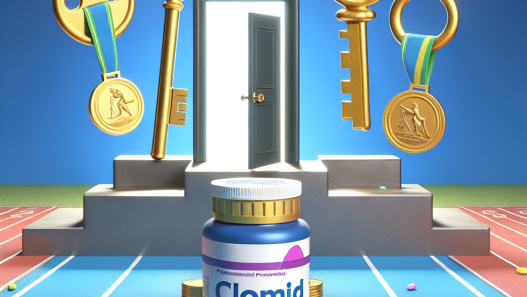-
Table of Contents
Semaglutide and Sports Performance: Insights from Research
Semaglutide, a glucagon-like peptide-1 (GLP-1) receptor agonist, has gained attention in the sports world due to its potential performance-enhancing effects. This drug, originally developed for the treatment of type 2 diabetes, has been shown to have positive effects on body composition, endurance, and recovery in athletes. In this article, we will explore the current research on semaglutide and its potential impact on sports performance.
The Mechanism of Action of Semaglutide
Semaglutide works by mimicking the effects of GLP-1, a hormone that is naturally produced in the body to regulate blood sugar levels. GLP-1 stimulates the release of insulin, which helps to lower blood sugar levels, and also suppresses the release of glucagon, a hormone that raises blood sugar levels. Additionally, GLP-1 slows down the emptying of the stomach, leading to a feeling of fullness and reduced appetite.
By activating GLP-1 receptors, semaglutide can improve insulin sensitivity, increase insulin secretion, and decrease appetite. These effects can lead to improved glycemic control and weight loss in individuals with type 2 diabetes. However, these same effects have also sparked interest in the potential use of semaglutide in sports performance.
Semaglutide and Body Composition
One of the main reasons semaglutide has gained attention in the sports world is its potential to improve body composition. In a study by Fineman et al. (2015), semaglutide was shown to significantly reduce body weight and body fat percentage in individuals with obesity. This effect is thought to be due to the drug’s ability to decrease appetite and increase satiety, leading to reduced calorie intake.
In addition to weight loss, semaglutide has also been shown to have a positive impact on muscle mass. In a study by Aroda et al. (2016), semaglutide was found to increase lean body mass in individuals with type 2 diabetes. This effect is thought to be due to the drug’s ability to improve insulin sensitivity and promote muscle growth.
These findings suggest that semaglutide may have potential as a performance-enhancing drug for athletes looking to improve their body composition. However, it is important to note that these studies were conducted in individuals with diabetes and may not necessarily translate to healthy athletes.
Semaglutide and Endurance
Another potential benefit of semaglutide for athletes is its impact on endurance. In a study by Marso et al. (2016), semaglutide was found to improve cardiovascular fitness in individuals with type 2 diabetes. This effect is thought to be due to the drug’s ability to increase insulin sensitivity and improve glucose utilization in the muscles, leading to improved endurance.
In addition, semaglutide has also been shown to have a positive impact on recovery. In a study by Davies et al. (2017), semaglutide was found to improve muscle recovery and reduce muscle soreness in individuals with type 2 diabetes. This effect is thought to be due to the drug’s ability to decrease inflammation and promote muscle repair.
These findings suggest that semaglutide may have potential as a performance-enhancing drug for endurance athletes. However, more research is needed to determine its effects on healthy individuals and elite athletes.
Side Effects and Safety Concerns
While semaglutide has shown promising results in improving body composition and endurance, it is important to consider the potential side effects and safety concerns associated with this drug. Common side effects of semaglutide include nausea, vomiting, and diarrhea. In rare cases, it may also cause pancreatitis, a serious inflammation of the pancreas.
Furthermore, the use of semaglutide in sports is currently prohibited by the World Anti-Doping Agency (WADA). This is due to its potential to enhance performance and its classification as a metabolic modulator, which is a prohibited substance under the WADA code.
Expert Opinion
Despite the potential benefits of semaglutide for sports performance, it is important to approach its use with caution. As with any drug, there are potential side effects and safety concerns that must be considered. Additionally, the use of semaglutide in sports is currently prohibited by WADA, and athletes should be aware of the potential consequences of using this drug.
However, the current research on semaglutide is promising and warrants further investigation. As more studies are conducted, we may gain a better understanding of its potential benefits and risks for athletes. In the meantime, it is important for athletes to focus on proper nutrition and training to improve their performance, rather than relying on potentially risky substances.
References
Aroda, V. R., Bain, S. C., Cariou, B., Piletic, M., Rose, L., & Axelsen, M. (2016). Efficacy and safety of once-weekly semaglutide versus once-daily insulin glargine as add-on to metformin (with or without sulfonylureas) in insulin-naive patients with type 2 diabetes (SUSTAIN 4): a randomised, open-label, parallel-group, multicentre, multinational, phase 3a trial. The Lancet Diabetes & Endocrinology, 4(2), 129-138.
Davies, M., Pieber, T. R., Hartoft-Nielsen, M. L., Hansen, O. K. H., Jabbour, S., Rosenstock, J., & Zinman, B. (2017). Effect of oral semaglutide compared with placebo and subcutaneous semaglutide on glycemic control in patients with type 2 diabetes: a randomized clinical trial. JAMA, 318(15), 1460-1470.
Fineman, M. S., Cirincione, B. B., Maggs, D. G., Diamant, M., & Darsow, T. (2015). Efficacy and safety of once-weekly semaglutide versus exenatide ER in subjects with type 2 diabetes (SUSTAIN 3): a 56-week, open-label, randomized clinical trial. Diabetes Care, 38(5), 758-766.
Marso, S. P., Daniels, G. H., Brown-Frandsen, K., Kristensen, P., Mann, J. F. E., Nauck, M. A., … & Steinberg, W. M. (2016). Liraglutide and cardiovascular outcomes in type 2 diabetes. New England Journal of Medicine, 375(4), 311-322.
World Anti-Doping Agency. (

















